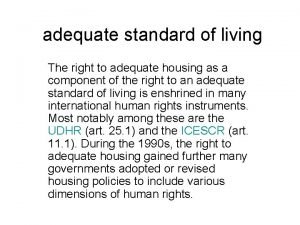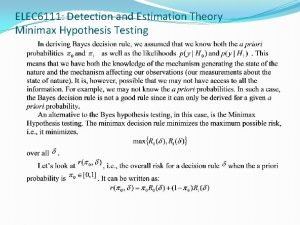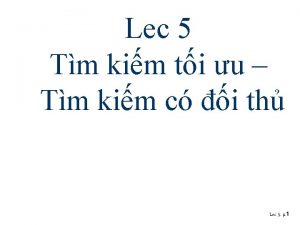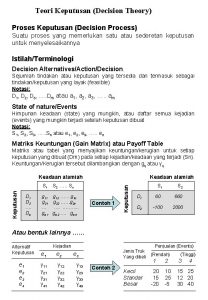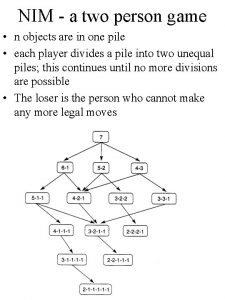Minimax Strategies Minimax Strategies Everyone who has studied






























- Slides: 30

Minimax Strategies

Minimax Strategies • Everyone who has studied a game like poker knows the importance of mixing strategies. – With a bad hand, you often fold – But you must bluff sometimes

Zero Sum Games • Define a zero-sum game, in which one firm’s profits are another firm’s losses. • Flipping coins or other betting games are straightforward examples of zero-sum games. • Positive sum games such as buying a product are more common in economics.

Why Zero Sum Games? • Zero sum games are easier to analyze • They show us an important extension of game theory.

An Example

An Example Since this is a zerosum game, we only display A’s gains, for B’s losses are exactly the opposite of A’s gains

An Example How should B play the game?

An Example There is not a dominant strategy here.

An Example If B always follows strategy B 1, A will always follow A 2. If B always follows strategy B 2, A will always follow A 1.

An Example That would suggest that A can only win $1 In fact A can do better.

A mixed strategy An Example A follows Suppose strategy A 1 sometimes; and other times, strategy A 2. A will always win $1 and sometimes $2 or $3, depending on what B does. Thus, it does better.

An Example B’s Response When B follows B 1, it l loses $1 part of the time and $3 part of the time. When it follows B 2, it loses $2 part of the time and $1 part of the time.

An Example B must mix strategies to minimize A’s winnings

An Example Suppose B 1 percent of the time B 2 (1 -p 1) percent of the time

A’s Winnings Remember, B is following strategy 1 percent of the time.

A’s Winnings

A’s Winnings

A’s Winnings If B is following the two strategies randomly, these are A’s optimal decisions

A’s Winnings The Minimax Strategy

A’s Winnings A will follow his best strategy. B must respond by minimizing his maximum winnings.

A’s Winnings That means setting p 1 = 1/3.

A’s Winnings This is the best B can do. It is following a strategy to minimizes A’s maximum gain.

A’s Winnings This is the minimax strategy

The Minimax Strategy • There is an obvious analogy to playing poker. If you always fold a poor hand raise a good hand, you will not make much money. – You must, on occasion, bet on a poor hand fold on a good hand. – If not, your opponent can “read” your bets and adjust his accordingly.

The Graphical Solution 3 2 1 0 1/3 2/3 1

The Graphical Solution • A’s payoffs from following strategy A 1 as a function of B’s probability of following B 1 3 2 1 0 1/3 2/3 1 • A’s payoffs from following strategy A 2 as a function of B’s probability of following B 1

The Graphical Solution 3 If p 1 = 0 ( B never plays strategy B 1), A maximizes his winnings by playing A 1 2 1 0 1/3 2/3 1

The Graphical Solution Given A’s ability to choose strategies, B does best (or loses the least) by setting p 1 =1/3 3 2 1 0 1/3 2/3 1

The Minimax Strategy • Any attempt to carry this further will lead us into advanced mathematics. • This quick introduction illustrates what can be one to set up strategy problems in a game theoretic framework.

End © 2003 Charles W. Upton
 Hello i hope all is well
Hello i hope all is well When everybody goes to a meeting the rebel
When everybody goes to a meeting the rebel Everyone has their own goals
Everyone has their own goals What does janie say to jody on his deathbed
What does janie say to jody on his deathbed She visited apls last year
She visited apls last year The right to an adequate standard of living
The right to an adequate standard of living I think almost everyone has heard
I think almost everyone has heard Everyone has exactly one best friend
Everyone has exactly one best friend Everyone has what it takes
Everyone has what it takes Heurystyka rozpoznawalności
Heurystyka rozpoznawalności Minmax regret
Minmax regret Minimax
Minimax Checkers minimax
Checkers minimax Minimax 2019 2020
Minimax 2019 2020 Minimax
Minimax Giải thuật minimax
Giải thuật minimax Trees in java collections
Trees in java collections Minimax algorithm
Minimax algorithm Contoh soal decision making
Contoh soal decision making Min max algorithm
Min max algorithm Maximin and minimax principle
Maximin and minimax principle Minimax maximin
Minimax maximin Minimax and maximin principle in game theory
Minimax and maximin principle in game theory Nim minimax
Nim minimax Minimax alpha beta pruning
Minimax alpha beta pruning Minimax utility
Minimax utility Minimax algorytm
Minimax algorytm Poda
Poda Tobbminttv
Tobbminttv Minimax elv
Minimax elv Algoritmo minimax
Algoritmo minimax





